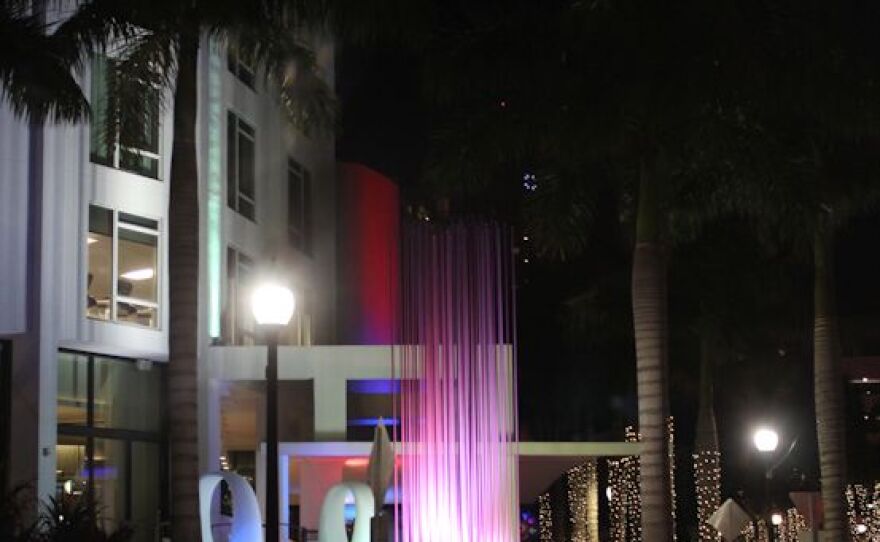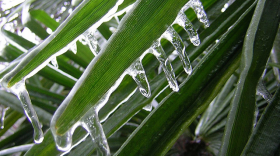Something exciting is happening in Sarasota. Public artworks are cropping everywhere you look. Residents and tourists aren’t just taking notice. They’re stopping, engaging, and basking in the ambiance. Officials with the Sarasota Office of Public Art say it's all part of their master plan.
City of Sarasota Senior Planner Mary Davis Wallace has worked as a landscape designer and urban planner in North Carolina, the United Kingdom, Spain and now Florida. She credits the pandemic with the public’s newfound interest in public art.
“Most people had an upset to their daily routine and they were walking the streets and they were utilizing the parks. All of a sudden public art became trendy and popular because people would take a walk to a public place that they’d never experienced before because they were so busy going to work, picking up the kids, you know, running to the grocery store," said Wallace. "So people are beginning to see the value of their public spaces and parks, and open spaces are great conduits for public art.”
Public art has a long tradition in Sarasota. It dates back to the arrival of John and Mable Ringling some one hundred years ago. In 1989, the City of Sarasota joined about 500 other municipalities and counties across the United States in adopting a percent-for-art program, but coming out of the pandemic, Sarasota’s public art program is poised for greatness.
“One of our goals, and values, really, in this program is that we want to make public art part of a person’s everyday life,” said Wallace.
In this effort, Sarasota’s program rests on four pillars. The first is the cutting-edge art-in-roundabouts initiative. In this regard, Sarasota is leading the state, if not the nation, in placing beautiful, soaring sculptures in the roundabouts that the City is using to replace traffic lights at busy intersections.
“We have a lot of roundabouts going in and we thought what better place to exhibit our beautiful sculpture than in these roundabouts? So we are pioneers in this process, and people are really excited about it,” she said.
It’s not just the people who live, work in, and visit Sarasota who are excited. Public art professionals around the state are hoping to take a page from Sarasota’s playbook and institute art-in-roundabout initiatives of their own. In fact, this was the topic of a workshop that was included in the annual conference of the Florida Association of Public Art Professionals that took place April 27 - 29 in, you guessed, scenic Sarasota.
“It’s also just such an opportunity for cities to highlight their public art program," said Wallace. "It’s proven that it’s safer when there’s public art around. So, we really want to encourage municipalities to use the data to back up why public art is a good thing in your city, but also why public art is good in a roundabout. You’re always wanting to slow traffic. You always want to get people safely through an intersection and we feel like art is a wonderful, enlightening, unique way to engage the driver in a safe way,” said Wallace.
Besides roundabouts, Sarasota wants to place art where people live.
“Typically, when you visit a city, most of the public art is going to be concentrated in the pedestrian downtown core area. Usually you interact with public art in a public space. You interact when you’re on your way to get a cup of coffee or to go to the theater, but we really want to start embedding public art into our neighborhoods and start activating our neighborhoods because these are also places where people spend a lot of time," said Wallance. "We want to encourage them to get outside, take a walk in your neighborhood, interact with public art and we also want them to be part of that story.”
This strategy is being embraced by numerous cities across the country. In Florida, the City of Gainesville has partnered with the University of Florida to improve and enhance the social, physical and economic aspects of the city’s neighborhoods through the use of art hubs. Fort Myers is doing the same, as is Tampa, which calls their program Art on the Block.
“You’d be surprised how many nooks and crannies are either part of the city right-of-way or owned by the city exist in neighborhoods," she said. "For instance, I was just travelling down a very old neighborhood in Sarasota the other day and came across this triangle shaped piece of land, and it happened to be something that was city-owned and maintained. What a beautiful place for a piece of art. So I think it’s a matter of contemplating what you want to do first, what message you’re trying to send, and then finding a location that’s going to be accessible to everyone.”
Then there are murals, which are all the rage not only in Florida, but around the globe.
“Putting paint on a wall is just the easiest way to bring people to a space. So, we are big supporters of murals. Murals can tell a story. Murals can tell a legacy of a city, a legacy of a neighborhood, and a lot of times murals activate a genre of artists that don’t always get the attention. We always talk about public artists as being sculptors or people who work in heavy materials, but mural artists are incredibly talented,” said Wallace.
Murals don’t just brighten up old buildings or blighted neighborhoods. Frequently, they tell stories about the history of those neighborhoods and the people who once lived there. In that sense, murals serve a place-keeping – as opposed to place-making – role.
Finally, Sarasota is working to activate and engage the next generation of public artists, city planners and art professionals by getting middle and high school kids involved. While Wallace waxes philosophically about the many ways public art fosters creativity, enhances quality of life and uplifts our psyches, she’s also mindful of the impact on the local economy.
“We have a huge art and culture economy here in Sarasota, and we’ve been known for that really since the inception of our city and we’ve taken great pride in the fact that people come to our city to experience the arts. They come to see a show. They come to go to a play. They come to see an art exhibit. They come to the Sarasota Film Festival. There’s a lot of people that come to our city to be engaged with the arts.”
Of course, it takes money to implement these plans, and in Sarasota, developers play an important part in subsidizing the public art program.
“If a developer comes in for a building permit and the cost of construction is over $1 million, they pay a half of one percent into the public art fund.”
Wallace concedes that some developers view this as a burden. When this happens, she simply reminds the developer that having public art or a mural located on or near their project not only makes the property more attractive to prospective tenants or buyers, it also gives them an edge as they compete for discerning people willing to pay top dollar for quality locations.
“We say, 'How many times do you tell a prospective buyer that this is the best place to live because of the arts and culture?' So, we want to draw the connection between marketing their new projects and saying, 'Come live in Sarasota where we have a vibrant arts and culture [scene],' and their contribution [in creating] the vibrant arts and cultural community that we have. So it’s also about making that connection, and many times, if not every time, the developer goes, ‘Oh yeah, that makes a lot more sense now.’”
With all this – and more – going on, Sarasota is setting an example for what public art can do for the people who reside, work there and visit the city.
N.B.: Mary Davis Wallace grew up in Asheville, North Carolina, where she developed a lifelong appreciation for the arts, architecture and design. She has worked as a landscape designer and urban planner in North Carolina, the United Kingdom, Spain and Florida. Her design and planning experience compelled her toward a deeper commitment to public art, which led her to her role as Executive Director of the public art nonprofit Cary Visual Art in Cary, North Carolina. There, she managed and promoted the public art collection in Cary as a premier arts destination within the entire Research Triangle Park area of more than 2 million residents. She went on to serve as the donor relations coordinator at Duke University School of Medicine before moving back to Sarasota in 2017. She comes to the City of Sarasota from Sarasota County government, where she was a park planner and construction project manger.



















